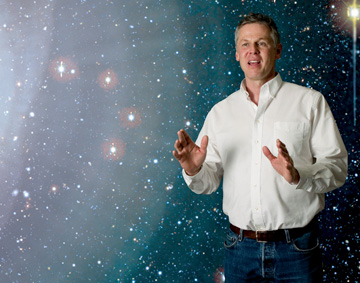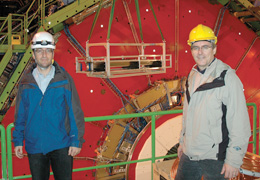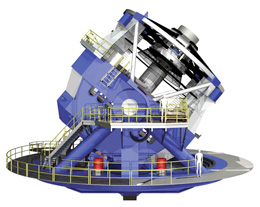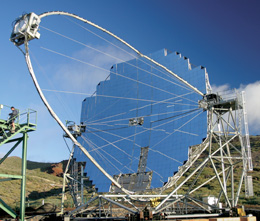Volume 25 · Number 3 · Spring 2008
Cosmic Convergence

Andreas Albrecht, professor of physics and cosmologist (Photo: Karin Higgins/UC Davis)
The sciences of the very large — cosmology — and of the very small — particle physics — are coming together. That could mean a giant leap in our understanding of the universe.
By Andy Fell
Around 300 years ago Isaac Newton showed that the same laws governed the fall of an apple and the movement of the planets, and he changed how we see the world. About a hundred years ago, Albert Einstein, Max Planck and others overturned the applecart and superseded Newton’s laws with the new theories of relativity and quantum physics. And we saw the world anew.
Now another revolution is coming, as cosmology and particle physics are converging to answer a fundamental question: What is the universe made of?
“We’re all cosmologists now,” says Lori Lubin, a physics professor in the observational astronomy group at UC Davis.
From tunnels under Switzerland to remote mountaintops and satellites, on desktops and blackboards and scraps of paper, in computers and around espresso machines, the instruments and ideas for this revolution are under construction. And UC Davis is in the thick of it.
A Glossary:
GPS and relativity: GPS navigation systems work by picking up the “tick-tock” of atomic clocks on satellites high above the Earth. As a result of relativity, the clocks on the satellites appear to run a few micro-seconds a day faster than a clock on the ground. That’s enough to build up errors of miles per day if engineers had not accounted for these effects.
Relativity, quantum physics and the Standard Model of particle physics all work extremely well within their realms. The Standard Model describes the particles that make up an atom and explains how the sun generates the photons that stream through my office window. Quantum physics allows the semiconductor circuits in my desktop computer to work. Were I to heave my computer out of the window, Newton’s equations would elegantly describe its progress toward the ground, although Einstein’s theory of general relativity says that it is actually moving along a curve in space-time.
Newton’s theories also show why satellites stay in orbit, and Einstein’s allow those satellites to beam signals to a GPS device that I can use to navigate within a few yards.
But these theories have their limits, indicating that “something else” must be going on. There are also gaps between theories. And then there are discoveries that just cannot be explained right now, such as the existence of “dark matter,” the second-most abundant stuff in the universe, and the most abundant, “dark energy,” which is making the expansion of the universe speed up.
All of which has physicists eager for new data and theories.
“There’s a tremendous ferment in physics now,” says Andreas Albrecht, a physics professor and cosmologist at UC Davis. “I find that incredibly exciting.”
Such fundamental questions may not have an obvious, short-term payoff in new technology or products. But consider that hundreds of years elapsed between Newton and orbital satellites, about a half-century between Planck’s and Einstein’s work on quantum physics and the transistor. We live in a technologically advanced society because of advances in fundamental science.
Today the center of attention for particle physicists is the Large Hadron Collider or LHC, nearing completion at CERN, the European Organization for Nuclear Research, in Switzerland. The giant accelerator has taken 13 years to build at a cost of $8 billion, shared between 55 partner countries including the U.S. Some 6,000 scientists are working directly on the project, including 11 professors and research physicists from UC Davis. Many more are eagerly waiting to see the data it produces.

Physics professor John Conway (right) and his colleague associate professor Maxwell Chertok visit CERN near Geneva, where they are involved with the construction of the Large Hadron Collider.
Einstein showed that energy is tied to mass, so at higher and higher energies more massive and fundamental particles come into view. The LHC will open up a completely new energy scale for study, says John Conway, a UC Davis physics professor involved with the project.
It will smash together two streams of protons, the positively charged particles found in the nucleus of the atom. Those collisions will throw off a spray of more fundamental particles, whose tracks will be captured by a series of huge detectors.
The LHC will hurl protons together with an energy of seven trillion electron-volts, about seven times that of the Tevatron at Fermilab in Illinois, currently the world’s most powerful accelerator. On top of that, the design of the LHC will produce particles at about 100 times the rate of the Tevatron, Conway says.
UC Davis theorist John Terning explains the concept this way: Imagine beings living within solid ice who are trying to understand their glacial universe. The ice scientists realize that at higher energy levels, water molecules should be able to move around, although in their world they are frozen in place. So they heat up a bit of ice, and it briefly turns to liquid, confirming their prediction.
In the same way, the LHC will heat up a small part of our universe and release particles that have not been seen since the Big Bang. The main quarry is the missing piece from the Standard Model: the Higgs boson.
Developed in the 1970s, the Standard Model explains all the fundamental particles that physicists have observed to date and fits them into an elegant “symmetry.” But the model does not explain the existence of mass or why some particles have different masses than others or no mass at all. The Higgs boson was added to the Standard Model to explain the existence of mass.
The Higgs boson creates a field that permeates all space, explains Markus Luty, a theorist who recently joined UC Davis from the University of Maryland. Particles gain mass from interacting with the Higgs field, like wading through treacle.
As co-author of the Higgs Hunter’s Guide, physics professor John “Jack” Gunion literally wrote the book on the Higgs boson in 1990. It was unimaginable then, he says, that it would take two decades to resolve the question. The 1993 cancellation of the Superconducting Supercollider, a giant particle accelerator to be built in Texas, delayed discoveries for a decade, he said.
Physicists have a pretty good idea of the mass of the Higgs boson, and it should appear at the energy levels generated in the LHC, if it is as massive as thought.
“We should get lots of Higgs bosons thrown out if they are where we think they are,” Conway says. “If not, it would be a real head-scratcher.”
Gunion, though, thinks that the Higgs may already be within reach but is hard to find. A “light” or less massive Higgs at about 100 million electron-volts, well within the range of existing machines like the Tevatron, is consistent with other theories and some data support it — but the signal predicted by these theories is weak and therefore hard to detect.
“It could be right there but might not be easy to see,” Gunion says.
In addition to finding the elusive Higgs boson, the LHC should resolve a major problem with the Standard Model. According to quantum physics, particles spontaneously flicker into different states and back again. These quantum fluctuations should, in theory, drive up the mass of the Higgs boson. To make the Standard Model calculations work, physicists have to add in a correction factor that checks out to 32 decimal places.
Luty compares having to add such a precise correction to seeing a pencil balanced on its point. “You know there must be something else going on,” he says.
There are a number of candidates for that “something else,” including extra dimensions of space-time beyond the four we live in and “supersymmetry” or “susy” (pronounced “suzy”). Both can be tested at the LHC.
Some theories propose extra dimensions that we do not notice because they are extremely small. Higher energies probe distances at smaller scales, so if such extra dimensions exist, they might be revealed by the LHC.
Supersymmetry holds that, for every particle in the Standard Model, there is a “superpartner.” For example, the “top quark” has a partner called “stop.” These superpartners cancel out the extra mass arising from quantum fluctuations, Conway says.
The supersymmetric particles should be fairly close in energy to their partners, putting them just out of reach of the Tevatron but easily visible at the LHC, Gunion says. If anything, the supersymmetry apple will fall before the Higgs boson.
While the LHC looks for the slightest wisps of particles, astronomers and cosmologists are studying the largest structures in the universe — and finding that their investigations are leading to the same question being posed by those studying the smallest particles: What is our universe made of? And this corollary: Why is the universe flying apart?
By the late 1970s, it was evident that there is far more “stuff” in the universe than we can see collected into stars and galaxies, says UC Davis physicist Tony Tyson. This extra “dark matter” makes up about a quarter of the universe, while regular matter and energy account for less than 5 percent.
“There are mountains of dark matter out there,” Tyson says.
Then a scientist at Bell Labs in New Jersey, Tyson began trying to measure this dark matter around 1979. Dark matter is invisible, but it does exert a gravitational pull on light. If you look at a distant galaxy and there is a clump of dark matter in between, the light from that galaxy will be slightly distorted, like a wavy mirage in the desert.
Through the 1980s, Tyson and colleagues developed ways to measure this cosmic mirage, or “gravitational lensing.” They showed how dark matter hangs in clumps around galaxies and clusters. It soon became evident that dark matter could not be “regular” matter: dust, planets or dead stars. It must be a completely different creature.
In fact, dark matter particles could be streaming through us all the time, Luty says, but we do not notice them because they do not interact with the stuff of which we are made.
Dark matter might be created at the LHC. Supersymmetric particles thrown out by colliding protons should rapidly decay into others, ending up with the lightest susy particle or LSP, Gunion says. The LSP would be invisible to the LHC’s detectors but would carry away a certain amount of energy. By looking for energy to disappear in exactly the right way, researchers could deduce the existence of the LSP. Gunion’s group at UC Davis has developed methods to reconstruct this chain of events and calculate the LSP mass.
Knowing that, scientists could work out the number of LSPs populating the early universe and determine if they explain the dark matter observations. If so, one complete theory would then fit together the Higgs boson, supersymmetry and dark matter, Gunion says.
“The key is to get it to all work simultaneously.”

LSST: Large Synoptic Survey Telescope (Illustration courtesy of LSST.org))
A new theory will also have to fit the data coming from new satellites and telescopes. Tyson is leading the effort to design and build a particularly notable one: the proposed Large Synoptic Survey Telescope, or LSST.
Most big telescopes trade breadth of field for a deeper view into space. The LSST, though, is designed to take a wide, deep view of the universe. From a mountaintop in Chile, it will map the entire visible night sky every three nights and do so again and again for 10 years.
Using the LSST, astronomers will be able to map with exquisite precision how dark matter clumps through space, Tyson says, and rule out some theories about dark matter.
The LSST could also help address an even deeper problem: the nature of “dark energy” — the other 70 percent of the universe, the force pushing space apart.
Astronomers have known since the 1930s that the universe is expanding, still being blown out from the Big Bang. Scientists assumed that gravity would eventually slow that expansion.
But just 10 years ago, astronomers discovered that the expansion is getting faster. Imagine throwing an apple in the air, and instead of falling back, the apple keeps going faster and faster into space.
The force driving that acceleration was named “dark energy.” But no one really has a good idea about what it is.
The current best guess is that dark energy represents the energy of “empty” space. In quantum theory, particles spontaneously flicker in and out of existence even in empty space. That means every cubic meter of space has a certain amount of energy in it. As the universe expands, its volume increases, and so does the amount of this mysterious energy, called “zero-point energy.”
Einstein actually proposed the presence of this energy and called it the “cosmological constant,” although he later described it as a mistake. When astronomers discovered cosmic acceleration in 1998, Einstein’s cosmological constant was resurrected as an explanation.
Unfortunately, calculations of the cosmological constant give a number that is too big by a factor of at least 1 followed by 120 zeroes, which is a pretty big pencil balanced on a very fine point. Again, something else is going on that we do not understand.
Here too, the LSST may help find an answer. Albrecht and Lloyd Knox, another professor in the cosmology group, recently sat on a national Dark Energy Task Force to advise the National Science Foundation, the Department of Energy and NASA on developing a dark energy research program.
The task force identified a large survey telescope, such as the LSST, as one of the most promising of the proposed experiments.
The telescope will be able to make accurate measurements of different kinds of objects — supernovae, dark matter clumps, galaxy clusters and patterns left in the sky by the sound of the Big Bang. Then theorists can put their ideas to the test.
“Because these structures are so large, their evolution is affected by these parameters we are trying to measure,” such as dark matter and dark energy, Lubin says.
Some insight could also come from the LHC.
“A deep understanding of particle physics from the LHC must impact dark energy — we just don’t know how,” Albrecht says.
“Dark energy is just a name for something we don’t understand,” Tyson says. “But it’s a sign that something is around the corner, some huge change in physics.”

MAGIC: Major Atmospheric Gamma-ray Imaging Cherenkov (Photo: Robert Wagner, Max Planck Institute for Physics)
A tantalizing hint of this “new physics” came recently from the MAGIC (Major Atmospheric Gamma-ray Imaging Cherenkov) telescope in the Canary Islands. MAGIC looks for gamma rays from objects deep in space by detecting the flash of light produced when they hit the atmosphere. Designed and built in less than 10 years at a cost below $10 million, it’s a small, nimble project compared to the LHC, says physics professor Daniel Ferenc.
In 2007, the MAGIC team, including Ferenc, and collaborators at CERN reported an intriguing result. They measured bursts of gamma rays from a black hole in a galaxy half a billion light years away and sorted them into high- and low-energy particles. The high-energy particles arrived at Earth four minutes later than the low-energy photons, although they appeared to be emitted at the same time.
If correct, that result would contradict the theory of relativity, which says that all photons must move at the speed of light. The delay could be caused by “quantum foam,” the researchers argue in a 2007 paper. Quantum foam is not a material, but a type of structure of space itself predicted by quantum gravity theory, an attempt to unite quantum physics and relativity at cosmic scales.
Ferenc noted that there could be other, less exciting explanations for the result, but “it shows that such measurements are possible.”
A true marriage of particle physics and cosmology could happen in the next decade, Conway says. The LHC should be producing data in 2009; the LSST, if approved, should begin work in 2014.
Few places are as well positioned as UC Davis to engage on all these fronts. The cosmology group was created in the late 1990s with the express aim of interacting with the particle physics group. More recently, a series of recruitments have reinforced the particle physics and high-energy theory groups.
For Conway’s generation of particle physicists, it’s a momentous time.
“We all have our fingers crossed that this new energy scale we are about to open up will have some new stuff for us to explore,” he says.
“I hope there’s something that shakes things up,” Albrecht says. “To be surprised — that’s why I got into physics.”
The apples are ready to drop.
Andy Fell writes about the sciences for the UC Davis News Service.
